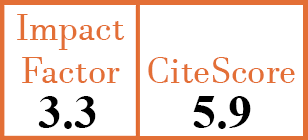Full Papers
Association of GTF2I and GTF2IRD1 polymorphisms with systemic lupus erythematosus in a Chinese Han population
Y. Li1, P. Li2, S. Chen3, Z. Wu4, J. Li5, S. Zhang6, C. Cao7, L. Wang8, B. Liu9, F. Zhang10, Y.Z. Li11
- Rheumatology & Clin.Immunology, Chinese Academy Med. Sciences & Peking Union Med.College, Key Lab.of Rheumatology & Clin.Immunology, Ministry of Education, Beijing; and Dept. Rheumatology, Affiliated Hosp. of Qingdao Univ. Med.College, Shangdong, China.
- Department of Rheumatology and Clinical Immunology, Peking Union Medical College Hospital, Chinese Academy of Medical Sciences & Peking Union Medical College, Key Laboratory of Rheumatology and Clinical Immunology, Ministry of Education, Beijing, China.
- Department of Rheumatology and Clinical Immunology, Peking Union Medical College Hospital, Chinese Academy of Medical Sciences & Peking Union Medical College, Key Laboratory of Rheumatology and Clinical Immunology, Ministry of Education, Beijing, China.
- Department of Rheumatology and Clinical Immunology, Peking Union Medical College Hospital, Chinese Academy of Medical Sciences & Peking Union Medical College, Key Laboratory of Rheumatology and Clinical Immunology, Ministry of Education, Beijing, China.
- Department of Rheumatology and Clinical Immunology, Peking Union Medical College Hospital, Chinese Academy of Medical Sciences & Peking Union Medical College, Key Laboratory of Rheumatology and Clinical Immunology, Ministry of Education, Beijing, China.
- Department of Rheumatology and Clinical Immunology, Peking Union Medical College Hospital, Chinese Academy of Medical Sciences & Peking Union Medical College, Key Laboratory of Rheumatology and Clinical Immunology, Ministry of Education, Beijing, China.
- Department of Rheumatology and Clinical Immunology, Peking Union Medical College Hospital, Chinese Academy of Medical Sciences & Peking Union Medical College, Key Laboratory of Rheumatology and Clinical Immunology, Ministry of Education, Beijing, China.
- Department of Rheumatology and Clinical Immunology, Peking Union Medical College Hospital, Chinese Academy of Medical Sciences & Peking Union Medical College, Key Laboratory of Rheumatology and Clinical Immunology, Ministry of Education, Beijing, China.
- Department of Rheumatology, The Affiliated Hospital of Qingdao University Medical College, Shangdong, China.
- Department of Rheumatology and Clinical Immunology, Peking Union Medical College Hospital, Chinese Academy of Medical Sciences & Peking Union Medical College, Key Laboratory of Rheumatology and Clinical Immunology, Ministry of Education, Beijing, China.
- Department of Rheumatology and Clinical Immunology, Peking Union Medical College Hospital, Chinese Academy of Medical Sciences & Peking Union Medical College, Key Laboratory of Rheumatology and Clinical Immunology, Ministry of Education, Beijing, China.
CER7853
2015 Vol.33, N°5
PI 0632, PF 0638
Full Papers
Free to view
(click on article PDF icon to read the article)
PMID: 26320362 [PubMed]
Received: 18/08/2014
Accepted : 07/01/2015
In Press: 31/08/2015
Published: 02/10/2015
Abstract
OBJECTIVES:
Systemic lupus erythematosus (SLE) is the most common systemic autoimmune disease which likely involves complex interactions between genes and the environment. Two large-scale genome-wide association studies (GWAS) have implicated many loci as genetic risk factors associated with primary Sjögren’s syndrome (pSS). Among them there are a number of pSS associated gene polymorphisms including the MHC-II, STAT4, IRF5, BLK, and TNIP1 genes that are shared with SLE. However, the association of other genes such as GTF2I, GTF2IRD1, and IL12A with SLE remain unknown. This study aimed to determine whether single nucleotide polymorphisms (SNPs) in GTF2I, GTF2IRD1 or IL12A genetically predispose a Chinese Han population to SLE.
METHODS:
Four SNPs in the GTF2I region (rs117026326), the GTF2IRD1 region (rs4717901), and the IL12A region (rs485497, rs583911) were genotyped in a cohort of 948 SLE patients and 938 healthy controls, using the polymerase chain reaction-ligation detection reaction (PCR-LDR) method.
RESULTS:
he frequency of risk allele of rs117026326 was notably higher in SLE patients than in controls (37.2% vs. 14.9%, OR: 3.39, 95%CI: 2.89-3.97, pc =3.31×10-54). Similarly, rs4717901 was also associated with SLE (35.3% vs. 20.2%, OR: 2.16, 95%CI: 1.86-2.50, pc =1.50×10-24). The frequencies of alleles and genotypes of IL12A SNPs were not significantly different between the SLE patients and controls.
CONCLUSIONS:
This study demonstrates a significant association between SLE and the GTF2I rs117026326 T allele, GTF2IRD1 rs4717901 C allele. The association of GTF2I and GTF2IRD1 as common genetic susceptibility factor in SLE will require further validation in other ethnic lines.



